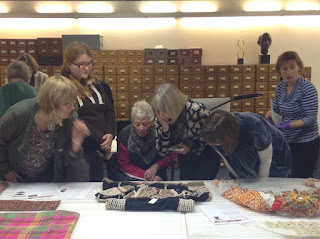Hello, I’m Beth, Assistant to the Director and
Administration. I also
have a background in Egyptology. In February this year I attended a lecture
given by Professor Richard Parkinson (Queen’s College,
Oriental
Institute, Oxford, and the British
Museum) for LGBT
History Month. The talk was entitled, ‘A Great Unrecorded History’: LGBT
Heritage and World Cultures and I found it incredibly inspiring. You can
watch the podcast here
and see if you find it as powerful as I did! What struck a particular chord
with me were Richard’s words that:
“One day, hopefully,
every museum will have at least one LGBT item openly identified as such on
permanent display, so that visitors of any sexuality can feel empowered by
their human heritage…Silent and implicit support is not enough...Public
gestures by institutions are crucial in embodying, consolidating and
legitimising our history. Prominent institutions have a responsibility to stand
up for inclusive human rights – prominently.”
I simply thought, why not? Why don’t we do that? The Pitt
Rivers Museum is a celebration of human experience and creativity, so surely we
have relevant objects? With the help and encouragement of my colleague, Helen
Adams, VERVE Project
Curator, and Lucy Shaw of the Oxford University Museums Partnership (OUMP), I applied to the OUMP
Innovation Fund to develop a trail similar to Richard’s in the British
Museum and his book, A
Little Gay History. One of the criteria was that the project had to
involve other museums and, so, the University’s first cross-collections trail
was born!
The specially commissioned trail highlights LGBTQ+ experiences across Oxfordshire and beyond. LGBTQ+ community members and allies volunteered to write about objects in the University Gardens, Libraries and Museums (GLAM) to queer the collections and offer alternative insights into the fascinating items looked after by the University. Many different objects have been considered for inclusion in the trail, here are just a few of them:
A Noh theatre mask from Japan showing Hannya, and angry female spirit (1884.114.56). During the Edo Period, women were banned from performing in Noh and Kabuki theatre, meaning that female roles were performed exclusively by men, but this is starting to change.
Natufian bone pendants from Mount Carmel in Palestine (1932.65.206-209). These were excavated by Francis Turville-Petre (1901-41), who was openly gay, in 1931.
In the words of Matt
Smith, the artist and curator behind the
Queering
the Museum project at Birmingham
Museum and Art Gallery in 2010-11,
“Unlike many groups whose culture is passed down from parents to children, there are few objects which can stand in for LGBT lives. Rather than universalising the group using totemic objects, museums need to work differently with interpretation about LGBT lives. It has been likened to detective work, looking into the cracks and fissures of collections since historically, the LGBT links with objects would often have been undocumented.”
“Unlike many groups whose culture is passed down from parents to children, there are few objects which can stand in for LGBT lives. Rather than universalising the group using totemic objects, museums need to work differently with interpretation about LGBT lives. It has been likened to detective work, looking into the cracks and fissures of collections since historically, the LGBT links with objects would often have been undocumented.”
If the University
of Oxford’s museums and collections
are to truly reflect human experience and achievement in all its forms, then
the LGBTQ+ experience should be explicitly represented. I sincerely hope this
pilot project will help address that!
Beth Asbury
Assistant to the Director and Administration Team
Assistant to the Director and Administration Team
I am indebted to my friends and colleagues who are helping me to run the project and design the trail booklet: Katherine Clough, Nicholas Crowe, Madeleine Ding and Jozie Kettle. With the help of the project’s volunteers, Jozie, Maddie and Nico are organising launch events for the trail, which are going to be amazing! I am also indebted to Richard, who is advising on the project, and the curators who have identified items in their collections for inclusion in the trail: Stuart Ackland (Bodleian Library), Mark Carnall (Museum of Natural History), who also co-ran the workshop, Jeremy Coote (Pitt Rivers Museum), Simon Glenn (Ashmolean Museum), Clare Harris (Pitt Rivers Museum), Dan Hicks (Pitt Rivers Museum), Stephen Johnston (Museum of the History of Science), Andy Lamb (Bate Collection), Julia Lenaghan (Ashmolean Museum), Charlotte McKillop-Mash (Bodleian Library), Liam McNamara (Ashmolean Museum), Laura Peers (Pitt Rivers Museum) and Matthew Winterbottom (Ashmolean Museum). Caroline Kennedy of the Equality and Diversity Unit has been incredibly helpful and supportive, and without her brilliant network of contacts we would not have had the wonderful group of volunteers who have given up their time, including weekends, to make this project work!
























